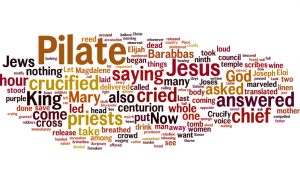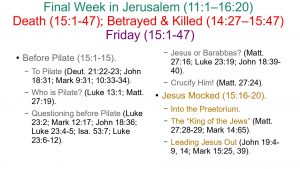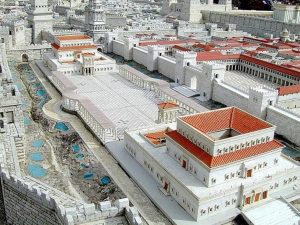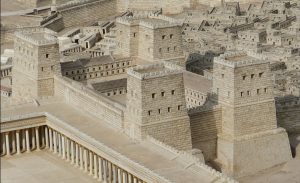Jesus’ Final Week in Jerusalem
Mark 11:1–16:20
Teaching (11:1–13:37)
King (11:1-11)
Sunday: Triumphal Entry (11:1-11).
Lawgiver (11:12–12:44)
Monday (11:12-19).
Tuesday (11:20–14:2).
Prophet (13:1-37)
Trial (14:1-72)
Sacrifice (14:1-26)
Wednesday (14:3-11).
Thursday (14:12-72)
Betrayed and Killed (14:27–15:47)
Death (15:1-47)
Before Pilate (15:1-15).
To Pilate (15:1).
Who was Pilate?
Pilate was the Roman governor (or prefect) of Judea from AD 26-36.
He was a ruthless man, as Luke records him slaughtering Jews on a particular feast day (Luke 13:1).
In fact, he was recalled because of such cruelty—he had slaughtered a group of Samaritans who were followers of a false christ near Mt. Gerizim looking for artifacts from the time of Moses.
So crucifying a Jewish man like Jesus would have been no big deal for him—except that it was, which goes to show how innocent Jesus truly was.
 After all, Pilate was not ignorant as to why these Jewish leaders wanted Jesus dead—it was because of envy (15:10).
After all, Pilate was not ignorant as to why these Jewish leaders wanted Jesus dead—it was because of envy (15:10).Not to mention his wife was having dreams about Jesus and pleaded with Pilate not to have anything to do with Him (Matt. 27:19).
These were not good reasons to kill someone, so Pilate was doing what he could to keep from crucifying Jesus.
There was a degree of cowardice here, since it was the Roman prefect’s job to keep the peace. In his mind that meant crucifying an innocent man and letting a murderer, a thief, and an insurrectionist go free—but I’m getting ahead of myself.
Questioning before Pilate.
The Jewish leaders had levied their charges against Jesus, framing it in a way they thought would be the most likely to get Pilate to execute Him.
They accused Him of “perverting the nation, and forbidding to pay taxes to Caesar, saying that He Himself is Christ, a King” (Luke 23:2).
Of course the first two things were absolutely false accusations—Jesus specifically said to pay taxes to Caesar, but they were on a roll with their lies and deceit, so why stop now? (Mark 12:17).
So Pilate asks Him point blank: “Are You the King of the Jews?”
Jesus answers in the affirmative, and John records what Jesus said about the nature of His kingdom, that it is not of this world and that His followers have no cause to fight (John 18:36).
This satisfies Pilate, but the chief priests continued to make baseless accusations against Him. They are desperate for something to stick (Luke 23:4-5).
Pilate expects Jesus to defend Himself, but He does not (Isa. 53:7).
Pilate is amazed at Jesus’ silence before His accusers.
Jesus will answer Pilate’s honest questions, but has no use for responding to the false accusations of the Jewish leaders.
This further shows Pilate that Jesus is an innocent man.
Nevertheless, Luke records that Pilate sends Jesus to see Herod Antipas since he is in town for the Passover and Jesus is under his jurisdiction (Luke 23:6-12).
But Herod sends Him back without charges, and we continue with Mark’s narrative.
Jesus or Barabbas?
Mark reveals a custom of Pilate that he released a prisoner at the feast, and John reveals that feast was the Passover (John 18:39).
Instead of Jesus, the people cry out for Barabbas to be released.
Taking all the gospel accounts, Barabbas was a notorious prisoner, a rebel, a murderer, and a thief (Matt. 27:16; Luke 23:19; John 18:40).
Surely, Pilate thought, this Jesus who calls Himself the King of the Jews is better than this murderer and insurrectionist!
No, they still call for Barabbas to be released, but we see that the deck is stacked as the chief priests had stirred up the crowd.
How easy is it for a crowd to be made to chant something when they might not even realize what they are saying? How easily we fall into that mob mentality.
Perhaps the priests started the chant. Perhaps they bribed a few key people to get it going. Perhaps they told the people the trumped up charges they had against Jesus as if it were fact. Perhaps all or some combination of the above.
It’s easy to think this is the same crowd that greeted Jesus as He came to Jerusalem on the back of a colt just days before, or that these were the same people touched by Jesus and His ministry.
But that doesn’t have to be the case, and probably isn’t. This was the Passover, and many more Jews had descended upon Jerusalem between Sunday and the Passover.
Many of them, if they had even heard of Jesus, may have thought He was just some wannabe messiah as many had come up before and since.
Whatever the case, they cried for this murderer to be released rather than the Son of God.
On a side note, why do you think Pilate keeps calling Jesus the King of the Jews? It could be a form of mockery or he could have been trying to make Him sound more appealing than the notorious Barabbas, particularly after his wife urges him to have nothing to do with the innocent Jesus (Matt. 27:19).
In any event, they cry for this King of the Jews to be crucified.
Crucify Him!
After they demand Jesus be crucified, Pilate wants to know why.
So frenzied, they provide no response but an insistence that He be crucified.
Such is often the logic behind a riotous mob.
Pilate was stuck between a rock and a hard place.
It was clear he wanted nothing to do with this innocent man’s death, as in another account, he washes his hands of the whole affair (Matt. 27:24).
But his job was the keep the peace, which sometimes meant placating the people.
Sadly, in this case, it meant executing an innocent Man.
He sees no alternative to keep the people from getting out of hand.
The typical treatment of one about to be crucified is to be scourged first.
They completely skip over the brutality of the scourging in all of the gospel accounts.
As one commentator puts it, “‘Flogging’ (φραγελλώσας, phragellōsas) often preceded crucifixions. The prisoner was stripped and bound to a post or thrown to the ground. The scourge was generally made of leather thongs, often fitted with pieces of bone or lead or with spikes [Brown 851]. The beatings varied in severity. Josephus describes incidents in which men were flogged until their bones lay visible [War ii.612; vi.304]” (Black 269).
While none of the accounts say exactly how bad the scourging was, two things mentioned later suggest it was quite severe: the need for help when carrying His cross and how quickly He died on the cross—but we’ll get to those things in time.
Accompanied with the scourging was the mockery.
Jesus Mocked (15:16-20).

The Praetorium is the building in the background on the left across the courtyard from Herod’s Palace with a red roof. Into the Praetorium.
The Praetorium was the location in any Roman province where the Roman emperor or representative would stay while he is in the area.
The Roman governors typically hated Jerusalem, so they would not spend their time there.
In fact, they built Caesarea on the coast for the governors to live most of the time.
But this was the Passover, a special feast day when every able Jewish male was supposed to descend upon Jerusalem—so of course the governor had to be there to keep the peace.
As you can see on the photo, the Praetorium here is across large courtyard from Herod’s palace, all behind a thick wall.

An alternate location for the place where Jesus was scourged is Antonia’s Fortress adjacent to the Temple Complex. It was here that the soldiers mock and ridicule our Lord.
The “King of the Jews.”
As Pilate had continued calling Jesus the King of the Jews, the soldiers must have heard that and decided it would be a fun game.
Of course, Romans typically did not believe in the sanctity of every human life, so their treatment of some Jew who thinks He’s king is not that unusual.
It shows the level of depravity these Roman soldiers will sink to, having called together the whole garrison to watch this, which may have been upwards of around 600 soldiers.
Before this mockery occurred, recall that Jesus had just been scourged, a brutal whipping that may have exposed bone.
With this in mind, we find that they did five more things to Him before they sent Him off to be crucified: clothed Him with purple, twisted a crown of thorns on His head, salute Him, hit Him and spat at Him, and pretended to worship Him—Matthew records they also gave Him a reed as a scepter (Matt. 27:29).
Interestingly enough, two of the other gospel accounts talk of the robe that Jesus was clothed in, Matthew and John (Matt. 27:28).
John agrees with Mark that it was purple, but Matthew says it was scarlet.
The Roman soldiers had plenty of red cloth lying around as part of their uniforms—it may have been faded enough to have bordered on scarlet and purple.
I mean, I have had navy blue shirts that some thought were purple after it had faded somewhat. This is no different.
Of course purple is the color of royalty, so it was a “fitting” mockery.
Keep in mind the bloody scourging He just experienced—His blood was sticking to the fabric as a bandage, then later casually ripped off, opening those wounds again.
As with the crown of thorns, a thorny garland that was dug into his head.
They hit Him in the head with a reed, perhaps the same reed or a similar one that they gave Him as a scepter.
And they spit on Him, not unlike the Jews who spat on Him earlier at His trial (14:65).
The soldiers then add insult to injury by saluting Him and calling Him the King of the Jews just as they would say, “Hail Caesar!”
Little do they know He is in fact the King of kings and Lord of lords.
Little do they know that, while they mockingly bow down and worship Him, He is worthy of all the worship in the world as its Creator and Sustainer and soon-to-be Savior.
We are looking at all these individuals and how they treated Jesus: Judas betrayed Him, Peter denied Him, the Jewish leaders were envious of Him and accused Him, and here we see the soldiers mock Him.
Who do you know that is like these soldiers? Putting up fronts, pretending to honor and worship the Lord on Sunday, but who don’t pay Him a second thought the rest of the week? Are we any better than they?
Leading Jesus out.
Before the soldiers remove the purple cloth, John records a few more things that happened (John 19:4-9).
I want to mention a couple of those things because they will play into what happens later, particularly in 15:39.
Pilate parades the beaten and bloodied Jesus in front of the people, reminding them that he finds no fault in Him. He says, “Behold the Man!”
The chief priests and officers continued to cry out, “Crucify Him!”
Pilate basically says he doesn’t want to, that they should do it instead.
Then we see the key phrase I want to focus on, that the Jews informed Pilate and the officers around him that, “He made Himself the Son of God.”
What was Pilate’s reaction? “He was the more afraid…” (John 19:8).
Why do you suppose Pilate was afraid of this accusation? After hearing of his wife’s dreams about Jesus and being convinced of His innocence, would it be so far-fetched for a Roman to believe this Jesus might be some kind of demigod as we see in Roman mythology? Maybe He was some powerful being—if he crucified Him, what terrible things might befall him as a result?
This is where the Roman centurion got the idea that Jesus was the Son of God, and his own confession as Jesus was dying, “Truly this Man was the Son of God!” (15:39) – more when we get there.
Well, after this, they tore the purple robe from off His back, and replaced His clothes. Then they lead Him out to be crucified.
This took place at around the sixth hour, according to John 19:14. Mark records that the crucifixion occurred at the third hour (15:25), which shows that John was using the Roman method of counting hours (6th hour = 6 AM), while Mark was using the Jewish method (3rd hour = 9 AM).



